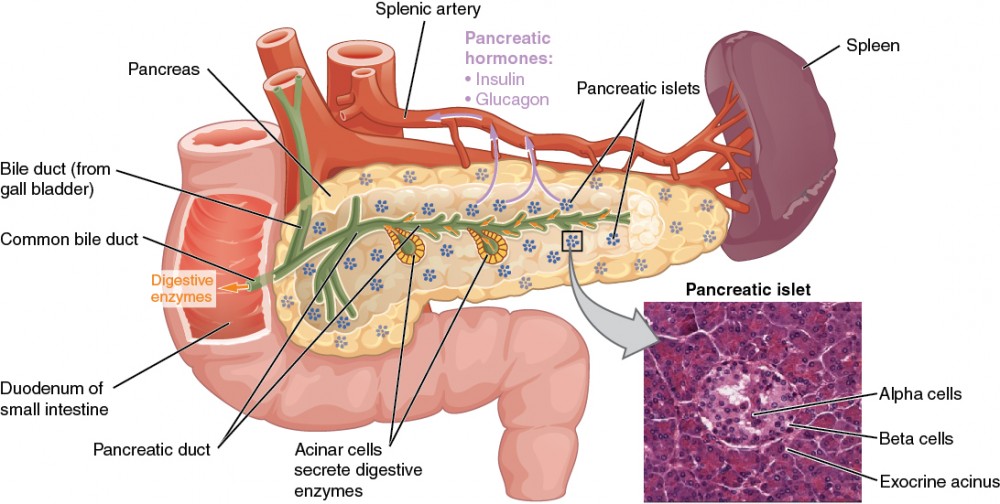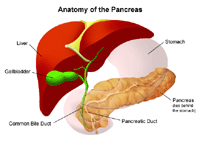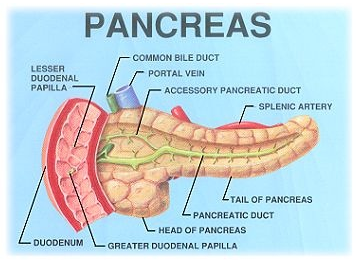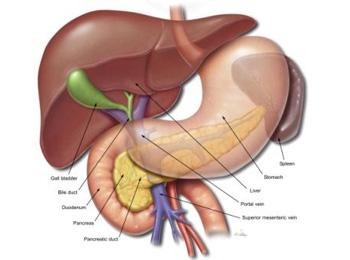Describe the Pancreas and Its Functions
The pancreas creates a wide range of different hormones some of which are used to trigger internal metabolic reactions and others which are used to help break down food. Pancreas and Its Function.

The Endocrine Pancreas Anatomy And Physiology Ii
- Because of the great power its enzymes.

. Insulin and glucagon are involved in the regulation of glucose metabolism. The liver has many functions but its main job within the digestive system is to process the nutrients absorbed from the small intestine. Functions of the pancreas.
The pancreas plays a vital role in converting the food into energy. During digestion your pancreas makes pancreatic juices called enzymes. Describe the anatomic location of the pancreas relative to the other organs in the upper portion of the abdominal cavity.
The Anatomy of the Pancreas Anatomy. It has five main parts the tail body neck head and uncinate process. Only about 1 of total weight of gland acts as endocrine gland.
The Lion of the Abdomen. Pancreas is considered as mixed gland as it acts as exocrine and endocrine gland. Bile from the liver secreted into the small intestine also.
The first helps you in digestion and is called the Exocrine Process. Insulin is the chief hormone in your body for metabolizing sugar. The endocrine portion is arranged as discrete islets of Langerhans which are composed of five different endocrine cell types alpha beta delta epsilon and upsilon secreting at least five hormones including glucagon insulin somatostatin ghrelin and pancreatic polypeptide.
The former of these. The pancreas is supplied by pancreatic arteries stemming from surrounding vessels and is innervated by the vagus nerve CN X celiac plexus and superior. The pancreas is really two glands that are mixed together into one organ with two separate functions.
Most people know that insulin is the hormone that helps the bodys cells put glucose into the cells for use as cellular fuel. Because of the deep location of the pancreas tumors of the pancreas may be difficult to locate. The pancreas has digestive and hormonal functions.
What are the 2 systems of the pancreas. - Its also called. The pancreas is a composite organ which has exocrine and endocrine functions.
The pancreas is an elongated organ thats approximately 15 centimeters cm long and has a tapered shape. Summarize the chemical digestion of carbohydrates proteins lipids nucleic acids 1310. These exocrine cells are called acinar cells and they produce and transport enzymes.
The enzymes secreted by the exocrine gland in the pancreas help break down carbohydrates fats and proteins. As endocrine glandit secretes hormones into blood. These enzymes break down sugars fats and starches.
- Blood sugar regulation. -exocrine portion important in the digestion of nutrients fat and protein -provides appropriate environment for enzymatic digestion in. These enzymes go down the pancreatic duct into the bile duct in an inactive form.
The bulk of the pancreatic tissue is formed by the exocrine component which consists of many serous pancreatic acini cells. - Because of its essential physiological functions. It mainly performs two functions.
The pancreas consists of exocrine glands that produce enzymes trypsin and chymotrypsin that are essential for digestion. The pancreas performs the following functions. The pancreas has both exocrine and endocrine functions.
It is called the Endocrine Process. These enzymes contain chymotrypsin and trypsin to digest proteins amylase for the digestion of carbohydrates and lipase to break down fats. It is located beneath the rib cage in the right upper abdomen.
The pancreas is a centralized organ vital for whole body metabolic control. Recent advances in the eld of metabolism have reinforced its importance for orchestrating endocrine hormone secretion in response to several nutrients including glucose lipids and amino acids in addition to hormones and inammatory signals. Outline the processes by which the various nutrient breakdown products are absorbed by the small intestine 1311.
These acini synthesize and secrete a variety of enzymes essential to successfully rest and digest. The pancreas plays a dual role in your bodily functions. The second helps to maintain and balance the bodys blood sugar glucose.
An exocrine function that helps in digestion and an endocrine function that controls blood sugar levels. A gland is a structure in the body that secrete hormones. The pancreas also makes insulin passing it directly into the bloodstream.
Whats the function of the the pancreas. Describe the location and look of the pancreas. One Organ Two Different Functions.
Insulin is a protein-based hormone that is made by the beta cells of the pancreas. Alpha cells of the pancreas produce glucagon while beta cells produce insulin. The pancreas is both an exocrine accessory digestive organ and a hormone secreting endocrine gland.
It is located inside your abdomen just behind your stomach. The pancreas is an accessory organ and exocrine gland of the digestive system as well as a hormone producing endocrine gland. Summarize the digestive functions of the small intestine and their regulation 139.
This portion of pancreas is known as Islet of Langerhans. The pancreas is tasked with two functions in your body. Insulin is produced by the beta cells in.
Technically the pancreas is a large gland. As exocrine gland pancreas secretes digestive enzymes into pancreatic duct. The pancreas secretes hormones including the blood sugar-regulating hormones.
It removes toxins from the bodys blood supply maintains healthy blood sugar levels regulates blood clotting and performs hundreds of other vital functions. The bulk of the pancreas is composed of exocrine exooutward cells that produce enzymes to help with the digestion of food. Describe the exocrine function of the pancreas and its regulation 138.
The pancreas is therefore said to have both an endocrine and exocrine functions in your body. In the absence of insulin the cells do not have enough biochemical energy so they must use other nutrients in. Describe the major roles of the pancreas.
Your pancreas plays a big role in digestion. Its about the size of your hand. It is a retroperitoneal organ consisting of five parts and an internal system of ducts.
The pancreas is an oblong flattened gland about six inches long located deep in the abdomen sandwiched between the stomach and the spine. What makes the pancreas unique is that it serves both exocrine and endocrine functions. - The pancreas is about 6 inches long and sits across the back of the abdomen behind the stomach and liver leveled with the top of the small intestine and it also borders the liver spleen and kidneys.
Your pancreas also helps your digestive system by making hormones.

The Pancreas Johns Hopkins Medicine

Pancreas Structure Hormones And Functions Online Biology Notes

No comments for "Describe the Pancreas and Its Functions"
Post a Comment